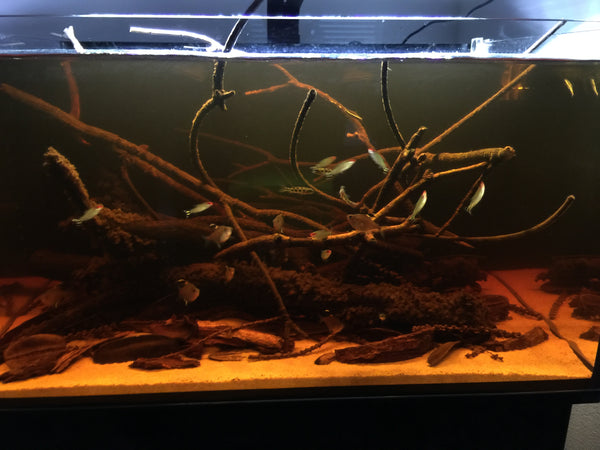- Continue Shopping
- Your Cart is Empty
Possibilities, theories...and assumptions...
We are at that "phase" in our understanding of the blackwater, botanical-style aquarium "practice" where we are beginning to develop some best practices, experiment a bit more, question lots of stuff...and make the occasional assumption of two.
Or more.

Huh?
Well, I'll be the first to admit that we have to operate on some theories now and again...for example, I am a big believer in diversity within the aquarium. Not just "diversity" in terms of fishes and plants and such- but in the context of all things added to our aquariums.
For example, I am of the opinion that it's beneficial to have lots of different types of botanical materials in your tank. Why?
Well, my theory goes something like this:
Most plant products contain some similar compounds, such as tannins, mic substances, minerals, etc. However, I believe that many contain varying qualities of these substances, and based on the structure/durability of the specific botanical, are released into the water at different rates as the materials break down.
And of course, there are other variables that no doubt come into the equation, such as how a botanical was prepared. How dry it was before immersion, the conditions under which the mother plant the botanical came from was growing under, the time of year it was harvested, etc., etc., etc.
I mean, it's a theory...an assumption of sorts.
However, I think it makes some sense, right? I mean, botanists know that specific plants and their leaves contain varying amounts of tannins and such. Some are more concentrated than others, and thusly, are more "potent" for our purposes...right?
Well, yeah, in theory, huh?
The reality of this is that we simply don't have all of the answers...or even all of the questions to ask to get the answers! We simply have to experiment.
We have to try stuff.
And, my theory sort of proffers that, with the potential variations in (desired) compounds present in various botanicals, that trying a variety in one situation sort of covers a number of possibilities at once.
Since I started playing with leaves and such, years ago, I've always sort of acted upon a leap of faith; a theory about what exactly they do. And this sort of tempted my work with them over the years. When I initially started, I was a bit hesitant, scared, even, of somehow poisoning my fishes and "crashing" my tanks.
However, it stood to reason that if some of these materials (leaves, seed pods, etc) are present in natural aquatics habitats around the world without killing fishes en masse, it would be perfectly okay to use them in an aquarium...right?
Well, yes. And no.
I mean, many of the materials that we have are not the exact botanical items found in every steam or river around the world. They are representative in many cases- facsimiles of what is found in nature. I mean, oak leaves are not found in Southeast Asia, right?
However, they accomplish the same thing that an Astrocaryum or Ceiba leaf might in it's native territory, right?
That's what I've theorized over the years...
And happily, it kind of worked out that way. As I experimented with more and more stuff, and saw very positive results with my fishes, I felt pretty confident that something beneficial was occurring as a result of adding this stuff to my aquariums!
There were, and continue to be- questions. And assumptions. Some which we simply have to make at this point, because we just don't have all of the information necessary to state with absolute certainty what is "correct."
Now, one could assume that the leaves and other parts of the plant which find their way into natural waters might contain varying combinations of certain compounds, thus releasing different amounts proportionally into the water...However, the essential "function" of any old leaf or seed pod breaking down in water is the same around the world, right?
Probably...I mean, likely...right?
Urghhh!

I mean, in a natural water course, you typically have more water volume than the average home aquarium, and it's an open ecosystem, with inputs from the surrounding environment, creating dilution. An aquarium is a closed system., and input/export to and from the environment is largely dependent upon us (the fish geeks) to control. And of course, being closed systems, it's entirely possible to "over-dose" our tanks with "stuff", isn't it?
Our aquariums likely can biologically and chemically assimilate and process only so much material, right? Sure. I mean, we've seen cases where over-zealous "tinters" have seen fishes gasping at the surface because they added too much stuff to quickly and the CO2 level rose rapidly as a result.
Yeah. Stuff like that.
And that's likely how the "You need to use 'X' number of Catappa leaves per liter of water" rules came about.
Trial and error...and conservative experiments.
I mean, I hate "rules" like that, specifically for natural materials which no doubt have varying levels of the compounds that we're interested in, based on so many possible factors...But it's a starting point, I guess. Until a sophisticated scientific assay of every leaf, every seed pod, and every type of wood that we utilize in aquariums is completed, determining average concentrations of _________ In a given sample size, "dosing" recommendations are just that...Recommendations.
Possibilities.
Theories.
Assumptions.
A starting point.
And that's okay, because this is a hobby. An art as much as it is a science.
And the idea is not to assume too much.
Rather, it's to experiment. Test, evaluate. Observe. Adjust. Rinse and repeat.
Sometimes, it's okay to assume...
Just not too much!
Today's little lesson in putting things into perspective in our tinted world.
Stay curious. Stay analytical. Stay fascinated. Stay focused...
And Stay Wet.
Scott Fellman
Tannin Aquatics












Scott Fellman
Author